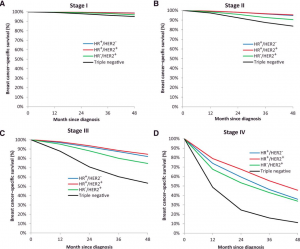31 3.10 Study Significance
Concluding Remarks and Study Significance
Triple-Negative and HER2-Enriched Breast Cancer are both highly aggressive tumors that are often associated with the poorest outcomes in the breast cancer cohort. Despite large advancements in HER2 treatment options and survival rates, the development of resistance against anti-HER2 therapy remains a robust challenge with a markedly negative effect on breast cancer prognoses (Gagliato et al. 2016). Furthermore, the incredible diversity and variable mutational profile underlying TNBC patients produces an even more daunting challenge in deciphering appropriate treatment options, while minimizing development of resistance (Mayer et al. 2014). Clearly, these aggressive cancers require treatment options equal in vigor, and able to tackle a range of proliferative pathways that Triple-Negative and HER2-Enriched Breast Cancers use to develop treatment resistance (Pernas and Tolaney, 2019).

Survival rates for breast cancers that overexpress Hormone Receptors (HR) or HER2, and triple-negative breast cancers after diagnoses at different stages of cancer progression (Howlader et al. 2018)
The results outlined in this chapter implicate Honey Bee Venom and its most prominent molecular constituent Melittin as highly potent anti-cancer molecules that may rapidly reduce cancer cell viability in vitro. Furthermore, Melittin was capable of targeting the HER2-Enriched and TNBC tumor cells with a high degree of specificity relative to that of healthy, non-transformed cells. In vivo, Melittin was capable of significantly improving the treatment efficacy of the chemotherapeutic Docetaxel, suggesting that Melittin may function as a synergistic combo partner to enhance our current treatments against triple-negative and HER2-Enriched breast cancers.
This work by Duffy et al. (2020) is dually exciting for both the promise of a novel cancer therapeutic that may effectively treat the most deadly forms of breast cancer, as well as a great leap in the consideration of Apitherapy as a useful and promising tool beyond alternative medicinal purposes. As far as transitioning this treatment from bench to bedside, there is still plenty of data and experimentation to be done, including investigations of maximum tolerable dose and optimal delivery method of Melittin/Honey Bee Venom in cancer patients. Alex Swarbrick, an Associate Professor at the Garvan Institute of Medical Research in Sydney added an important point:
“Many compounds can kill a breast cancer cell in a dish or in a mouse. But there’s a long way to go from those discoveries to something that can change clinical practice”
With that said, the next section will discuss just a few of the important future research directions that will likely build upon the findings of this study. There is a long road ahead, but these results serve as an incredibly encouraging step toward the development of effective novel weapons in the fight against breast cancer.
References
- Gagliato D. D., Jardim D. L., Marchesi M. S., & Hortobagyi G. N. (2016). Mechanisms of resistance and sensitivity to anti-HER2 therapies in HER2 breast cancer. Oncotarget, 7(39). doi:10.18632/oncotarget.7043
- Mayer I. A., Abramson V. G., Lehmann B. D., & Pietenpol J. A. (2014). New Strategies for Triple-Negative Breast Cancer – Deciphering the Heterogeneity. Clinical Cancer Research, 20(4), 782-790. doi:10.1158/1078-0432.ccr-13-0583
- Pernas S., & Tolaney S. M. (2019). HER2-positive breast cancer: New therapeutic frontiers and overcoming resistance. Therapeutic Advances in Medical Oncology, 11. doi:10.1177/1758835919833519
- Howlader N., Cronin K. A., Kurian A. W., & Andridge R. (2018). Differences in Breast Cancer Survival by Molecular Subtypes in the United States. Cancer Epidemiology Biomarkers & Prevention, 27(6), 619-626. doi:10.1158/1055-9965.epi-17-0627
